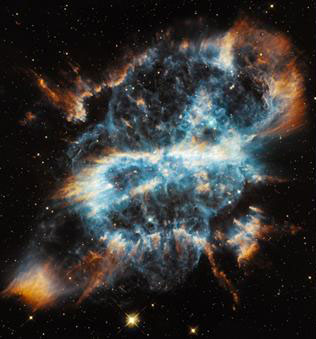| Oct 28, 2014 |
Laser experiments mimic cosmic explosions and planetary cores
|
|
(Nanowerk News) Researchers are finding ways to understand some of the mysteries of space without leaving earth. Using high-intensity lasers at the University of Rochester's OMEGA EP Facility focused on targets smaller than a pencil's eraser, they conducted experiments to create colliding jets of plasma knotted by plasma filaments and self-generated magnetic fields, reaching pressures a billion times higher than seen on earth.
|
|
In two related experiments, researchers used powerful lasers to recreate a tiny laboratory version of what happens at the beginning of solar flares and stellar explosions, creating something like a gigantic plasma tsunami in space. Much of what happens in those situations is related to magnetic reconnection, which can accelerate particles to high energy and is the force driving solar flares towards earth.
|
|
In a separate experiment, high-power lasers were focused on a small sphere to create intense shock waves, producing some of the highest pressures ever measured—nearly a billion atmospheres. The results provide information on how matter behaves at very high density, such as in the metallic cores of gas-giant planets and in imploding capsules for inertial fusion energy development.
|
 |
| This is a Hubble Telescope photo of an exploding star (NGC 5189), ejecting a large fraction of its mass into space in tangled filaments of dust and plasma. The processes at work in shaping such explosions are gradually coming to light through computer simulations, space telescope data, and laboratory experiments. (Image: NASA)
|
|
Laborytory experiment aims to identify how tsunamis of plasma called 'shock waves' form in space
|
|
William Fox, a researcher at the U.S. Department of Energy's Princeton Plasma Physics Laboratory, and his colleague Gennady Fiksel, of the University of Rochester, got an unexpected result when they used lasers in the Laboratory to recreate a tiny version of a gigantic plasma tsunami in space.
|
|
These tsunamis, called "shock waves," are thin areas found at the boundary between a collapsed supernova, a ball of super-hot, electrically charged gas called plasma, and the colder material around it. At that boundary is a steep, tsunami-like wall of plasma that has a turbulent magnetic field that sweeps up plasma to create the tsunami. Cosmic rays, extremely high-energy space particles, play a role in the tsunamis as they interact over and over again with the tsunami's turbulent magnetic field.
|
|
The researchers used two very powerful lasers to zap two pieces of plastic in a vacuum chamber to 10 million degrees and create two colliding plumes of extremely hot plasma.
|
|
Researchers were able to analyze what happened when the plasmas collided by using a third laser to send a beam of protons through the colliding plasma. The protons struck layers of film on the other side. The layers of film separated the various energies of protons in the beam.
|
|
Fox and Fiksel found that when the two plasmas merged they broke into clumps of long thin filaments called a "Weibel instability." It was the first time this instability was identified in a laboratory and was not predicted by the researchers themselves.
|
|
The researchers believe the Weibel instability is what causes the turbulent magnetic fields that form the tsunamis, or shock waves, in space. This magnetic field is also what pushes on and accelerates cosmic rays.
|
|
Their research could help answer questions about the origin of primordial magnetic fields that formed when galaxies were created and could help researchers understand how cosmic rays work and how plasmas are produced.
|

